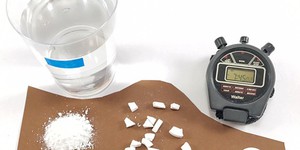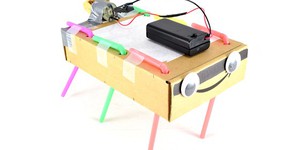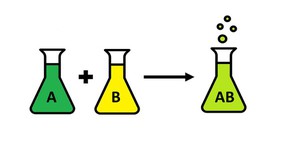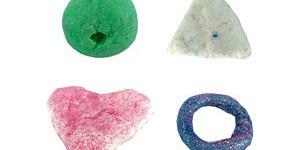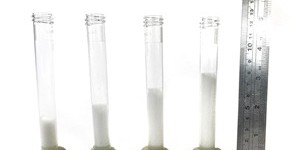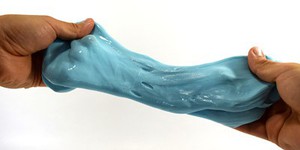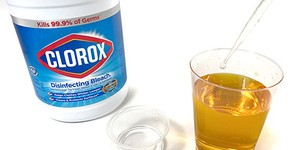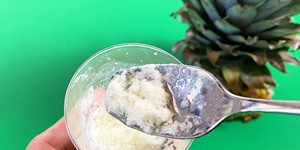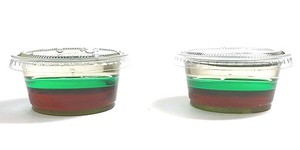Chemistry Lesson Plans (21 results)
An experienced chemistry professor used to say that it took about one explosion per week to maintain college students' attention in chemistry lectures. At that rate, we'd get in pretty big trouble with a lot of parents and teachers! Don't worry, we still have lots of bubbles, fizzes, bangs, and color changes for you to explore.
|
Select a resource
Sort by
|
Lesson Plan
Grade: 9th-12th
3 reviews
How does surface area affect the speed of a chemical reaction? Let your students find out in this sizzling lesson plan! In this project, they will explore this correlation by crushing Alka-Seltzer® tablets into different sized particles and measuring how long it takes for them to dissolve in water.
Read more
NGSS Performance Expectations:
Featured
Lesson Plan
Grade: 6th-8th
7 reviews
Junkbots are easy-to-build robots that you can make using a simple circuit and some recyclable materials. In this lesson, your students will learn about engineering design as they compete to build the fastest robot. No previous robotics experience is required!
Read more
NGSS Performance Expectations:
Lesson Plan
Grade: 9th-12th
7 reviews
This lab discusses types of reactions and replaces traditional reaction experiments involving chemicals such as lead (II) nitrate, barium chloride, and silver nitrate with greener alternatives. This lab is designed to challenge students to identify types of chemical reactions and distinguish between those that use safer, less hazardous chemicals and those that are more dangerous. Students will make a choice as to which reaction they will perform using the 12 Principles of Green Chemistry. They…
Read more
New
Lesson Plan
Grade: 6th-12th
Create a two-part system for filtering greywater. Teams will focus on communication and systems engineering as they build separate components to filter solid and liquid waste and then combine them into one device.
Learning Objectives
Students will:
Consider the potential effects of drought and how greywater could be part of the solution.
Design a system for filtering out solid waste or liquid waste.
Consider effective communication strategies with their team.
Collaborate on their design…
Read more
Lesson Plan
Grade: 6th-8th
27 reviews
Teach your students how to make plastic out of milk in this hands-on lesson plan! You will conduct a simple milk-transforming experiment to explore how plastics can be derived from a natural resource such as milk. Students will perform their own experiments and can even create a product from their resulting organic casein polymer.
Read more
NGSS Performance Expectations:
Video Lesson
Grade: 6th-8th
8 reviews
Chemical reactions can result in interesting products! In this lesson, students learn how plastics are made by conducting a polymerization reaction in a simple milk-to-plastic transforming experiment. During their experiments, students will be able to compare the physical properties of their reactants (milk and vinegar) and their resulting organic casein polymer.
Read more
NGSS Performance Expectations:
Lesson Plan
Grade: 9th-12th
1 review
In this lesson, students will employ the enzymatic decomposition reaction of hydrogen peroxide to investigate how chemical reactions are affected by enzymes and different substrate concentrations. Students will be challenged to control the rate of the reaction by adjusting the amount of substrate and thus changing the catalase activity. Foam production, created by the enzymatic breakdown of hydrogen peroxide into water and oxygen, will function as a proxy for the reaction rate. Based on their…
Read more
NGSS Performance Expectations:
Lesson Plan
Grade: 3rd-5th
4 reviews
There are many different ways to make slime. In this lesson plan, your students will use the engineering design process to design their own slime product. They will need to decide on the desired properties for their slime and then experiment to find the best recipe.
Read more
NGSS Performance Expectations:
Lesson Plan
Grade: 9th-12th
7 reviews
Teach your students how temperature affects chemical reaction rates in this highly visual experiment! Students will investigate color change during the reaction of food color with bleach, and measure the reaction times for different reaction temperatures.
Read more
NGSS Performance Expectations:
Lesson Plan
Grade: 5th
In this fun chemistry lesson, students will explore chemical reactions by mixing pineapple juice and milk. Students will observe whether the properties of milk change when it is mixed with pineapple juice, as well as how they change. They will then infer from their results whether a chemical reaction happened. In the process, they will not only learn about chemical reactions but also discover the importance of enzymes and their role in the human body.
Read more
NGSS Performance Expectations:
Lesson Plan
Grade: 2nd
4 reviews
When discussing material properties, most of us usually think of solid materials and material properties such as hardness, flexibility, or strength. However, liquids are characterized by distinct properties, too. Some of these properties overlap with those of solids, like density or transparency, but others are more specific to liquids. Viscosity—the resistance of a fluid to flow—and surface tension, are two examples of properties that are specifically used to characterize liquids.…
Read more
NGSS Performance Expectations:
Lesson Plan
Grade: 6th-8th
How do "instant" cold packs get cold when they are stored at room temperature, unlike a regular ice pack which must be stored in the freezer? In this lesson plan, students will explore several endothermic and exothermic reactions, and use their observations to choose the chemical reaction that best fits the design constraints for their own chemical cold pack.
Read more
NGSS Performance Expectations:
|
Explore Our Science Videos
Make a Slushy! Yummy STEM Project
Make a Hygrometer to Measure Humidity – STEM activity
Hydroponics in a 2-Liter Soda Bottle – STEM activity.


